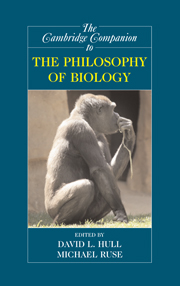Book contents
- Frontmatter
- 1 Adaptation
- 2 Population Genetics
- 3 Units and Levels of Selection
- 4 What’s Wrong with the Emergentist Statistical Interpretation of Natural Selection and Random Drift?
- 5 Gene
- 6 Information in Biology
- 7 Reductionism (and Antireductionism) in Biology
- 8 Mechanisms and Models
- 9 Teleology
- 10 Macroevolution, Minimalism, and the Radiation of the Animals
- 11 Philosophy and Phylogenetics: Historical and Current Connections
- 12 Human Evolution: The Three Grand Challenges of Human Biology
- 13 Varieties of Evolutionary Psychology
- 14 Neurobiology
- 15 Biological Explanations of Human Sexuality: The Genetic Basis of Sexual Orientation
- 16 Game Theory in Evolutionary Biology
- 17 What Is an ‘Embryo’ and How Do We Know?
- 18 Evolutionary Developmental Biology
- 19 Molecular and Systems Biology and Bioethics
- 20 Ecology
- 21 From Ecological Diversity to Biodiversity
- 22 Biology and Religion
- 23 The Moral Grammar of Narratives in History of Biology: The Case of Haeckel and Nazi Biology
- Reference List
- Index
- Series List
22 - Biology and Religion
Published online by Cambridge University Press: 28 April 2008
- Frontmatter
- 1 Adaptation
- 2 Population Genetics
- 3 Units and Levels of Selection
- 4 What’s Wrong with the Emergentist Statistical Interpretation of Natural Selection and Random Drift?
- 5 Gene
- 6 Information in Biology
- 7 Reductionism (and Antireductionism) in Biology
- 8 Mechanisms and Models
- 9 Teleology
- 10 Macroevolution, Minimalism, and the Radiation of the Animals
- 11 Philosophy and Phylogenetics: Historical and Current Connections
- 12 Human Evolution: The Three Grand Challenges of Human Biology
- 13 Varieties of Evolutionary Psychology
- 14 Neurobiology
- 15 Biological Explanations of Human Sexuality: The Genetic Basis of Sexual Orientation
- 16 Game Theory in Evolutionary Biology
- 17 What Is an ‘Embryo’ and How Do We Know?
- 18 Evolutionary Developmental Biology
- 19 Molecular and Systems Biology and Bioethics
- 20 Ecology
- 21 From Ecological Diversity to Biodiversity
- 22 Biology and Religion
- 23 The Moral Grammar of Narratives in History of Biology: The Case of Haeckel and Nazi Biology
- Reference List
- Index
- Series List
Summary
INTRODUCTION
The historical, conceptual, and cultural interplay between biology and religion involves a complex and philosophically fascinating set of relationships. Certainly the simple view that religion has uniformly been a hindrance to biological research is an unfair caricature. Religion has sometimes had a positive effect, often indirectly stimulating or even directly encouraging scientific research of the biological world. Similarly, biology has had a profound effect on religion, sometimes offering challenges that require believers to reassess basic theological assumptions. Scholars have examined both directions of influence, finding both expected and unexpected connections (e.g., Cantor 2005, Rolston 1999, Russell, Stoeger, and Ayala 1999). This chapter will give a necessarily selective account of some of the mutual influences between biology and religion. Its major purpose will be to highlight a deep pattern underlying their interplay, namely, the pervasive effect of the religious idea of the divinely created normativity of nature.
How this pattern is exemplified in multiple ways in the ongoing creationist controversy will be a recurring example, but we will also examine how it may be seen in a wide range of issues from questions about what it means to be human; to religious warnings against “playing God”; to views about gender roles and sexual morality, environmentalism, personhood, and the status of the fetus; and ultimately to metaphysics and the question of ultimate priority in creation. We begin by looking at biological evolution, a critical topic that intertwines with many of these other cases.
- Type
- Chapter
- Information
- The Cambridge Companion to the Philosophy of Biology , pp. 410 - 428Publisher: Cambridge University PressPrint publication year: 2007



